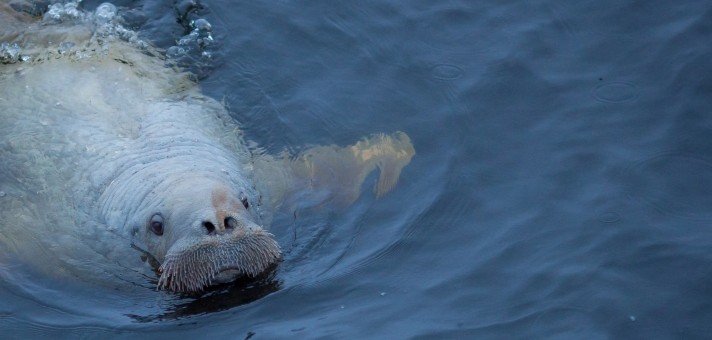Head of the Laboratory Ph.D (Biology) Vadim V. Kuklin
Brief History
 Current trends in the study of the Arctic seas avifauna, as well as the changed socio-economic circumstances, the reforming of Russian Academy of Sciences have led to the establishing of the Ornithology and Parasitology Laboratory in 2007. It joined the two oldest scientific divisions of the Institute: an ornithology laboratory and a sector of marine parasitological investigations. Until 2008 the Laboratory was a part of Marine mammals and birds department, since 2008 it is an independent scientific unit of MMBI RAS. Investigations here are carried out within a framework of the basic Scientific Research subjects, Federal Target Programs, regional and economical contract subjects. Scientific staff of the laboratory regularly takes part in expeditions in coastal areas of the Kola Peninsula, in the south-eastern part of the Barents Sea (the Pechora Sea), the Seven Islands Archipelago, Frantz Josef Land, Novaya Zemlya, Spitsbergen, carries out surveys and ship observations in the Barents Sea and the White Sea, and ice break cruises in eastern areas of the Russian Arctic.
Current trends in the study of the Arctic seas avifauna, as well as the changed socio-economic circumstances, the reforming of Russian Academy of Sciences have led to the establishing of the Ornithology and Parasitology Laboratory in 2007. It joined the two oldest scientific divisions of the Institute: an ornithology laboratory and a sector of marine parasitological investigations. Until 2008 the Laboratory was a part of Marine mammals and birds department, since 2008 it is an independent scientific unit of MMBI RAS. Investigations here are carried out within a framework of the basic Scientific Research subjects, Federal Target Programs, regional and economical contract subjects. Scientific staff of the laboratory regularly takes part in expeditions in coastal areas of the Kola Peninsula, in the south-eastern part of the Barents Sea (the Pechora Sea), the Seven Islands Archipelago, Frantz Josef Land, Novaya Zemlya, Spitsbergen, carries out surveys and ship observations in the Barents Sea and the White Sea, and ice break cruises in eastern areas of the Russian Arctic.
Investigations here are mostly directed towards the following aspects:
- analysis of the current state of the avifauna of the Barents and White Seas (species composition, population dynamics, trophic features, breeding success, migration routes);
- investigation of ornithological communities and regularities of bird distribution within water areas of the northern seas, including areas of expected extraction of hydrocarbons in the Arctic shelf;
- climatic and anthropogenic factors in the Euro-Arctic region, its impact on seasonal and long-term dynamics of the marine avifauna;
- basic features of ecology, reproduction and behavior of marine birds from anthropogenic landscapes;
- identification of environmental aspects that determine the composition, structure and dynamics of helminth fauna of birds from the northern seas;
- general parasitological situation in coastal areas and on the Barents Sea open waters, the role and significance of different “host” species for the circulation of parasites in the northern seas;
- multidisciplinary analysis of mutual adaptation in the system “parasite-host”.
At work

Basic findings are:
- Based on satellite navigation, a complete mapping of concentrations of seabirds wintering in the polynyas of the White Sea and adjacent to the Kola Peninsula coast waters of the Barents Sea was carried out. Recommendations for integrated monitoring of birds were developed;
- The current state and development trends of the largest seabird colonies on the Kola Peninsula coast (from the North Cape to the Cape Svyatoy Nos) and on breeding grounds of the Franz Josef Land were described;
- It was determined that two populations of the common eider Somateria mollissima - endemic (White Sea) and Murmansk - live within the White Sea; the boundaries of geographical ranges of these populations are established at different periods of the birds life cycle: reproduction, moulting and wintering;
- Background description of avifauna in the areas of proposed industrial hydrocarbons production was received; recommendations for the avifauna protection by environmental services and extractive companies were developed;
- It was found out that in the late 80’s large-scale changes in trophic conditions in the southern part of the Barents Sea launched the process of synanthropization of the silver gull, which has ultimately led to the formation of its “urban population” in Murmansk;
- Results of a comprehensive year-round parasitologic monitoring of the Kola Bay coast allowed identifying factors ensuring a different degree of success in the circulation of various parasite species in the tidal zone in different seasons;
- Main functioning regularities of the parasitic systems where seabirds are considered to be final hosts in open areas of the Barents Sea were identified;
- Correlations between specific features of parasitic invasion of seabirds and levels of concentration of persistent organic pollutants and heavy metals in their organism were traced;
- The influence of parasitizing tapeworms from different systematic groups on the digestive functions of seabirds was studied. It was found out that the nutrition of helminths occurs both with the help of own ferments and ferments adsorbed from the host intestine;
- It was shown that the degree of negative influence of parasites on seabirds metabolism in the host organism depends on the degree of vermination.
The ornythology and parasitology laboratory employees:
Kuklin Vadim Vladimirovich (in Russian)
Kuklina Marina Mikha’lovna (in Russian)
Krasnov Yuriy Vladimirovich (in Russian)
Goryaev Yuriy Igorevich (in Russian)
Ezhov Aleksey Victorovich (in Russian)





